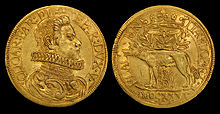Doubloon
The doubloon (from Spanish doblón, or "double", i.e. double escudo) was a two-escudo gold coin worth approximately $4 (four Spanish dollars) or 32 reales,[1] and weighing 6.766 grams (0.218
Doubloons were minted in Spain and the viceroyalties of New Spain, Peru, and New Granada (modern-day Colombia, Ecuador, Panama, and Venezuela). As the Spanish escudo succeeded the heavier gold excelente (or ducado, ducat; 3.1 g vs 3.48 g fine gold) as the standard Spanish gold coin, the doubloon therefore succeeded the doble excelente or double-ducat denomination.In modern times, the doubloon is remembered due in large part to the influence of historical fiction about piracy.[4]
History
Spanish American gold coins were minted in one-half, one, two, four, and eight escudo denominations, with each escudo worth around two Spanish dollars or $2. The two-escudo (or $4 coin) was the "doubloon" or "pistole", and the large eight-escudo (or $16) was a "quadruple pistole".
English nomenclature was confusing, though, since the $8 "double pistole" was the doubloon in English usage, while the $16 "quadruple pistole" was the doubloon in American colonial usage. This was disambiguated in references by calling the $4 the common doubloon or simply doubloon, the $8 the doubloon of four (escudos), and the $16 the doubloon of eight.
After the War of 1812, doubloons of eight were valued in Nova Scotia at the rate of £4 and became the dominant coin there.[6]
Doubloons, when exchanged for $4 or 32 reales in silver, traded at a high gold-silver ratio of 16 (since each real contained 3.833 g of 0.917 silver). Since the prevailing ratio in Europe was 15 in most of the 18th century, doubloons occasionally traded at a discount to this amount, at 30–32 reales.
In Spain, doubloons were current for $4 (four
In other countries

Doubloons have also been minted in Portuguese colonies, where they went by the name dobrão, with the same meaning. The São Tomé and Príncipe dobra is the only extant currency with a name meaning "doubloon."[7]
In Europe, the doubloon became the model for several other gold coins, including the French
See also
- Spanish dollar, also known as a piece of eight
- Brasher Doubloon
- Moby Dick Coin
References
- ^ "Doubloon". Dictionary.com. Archived from the original on 2015-09-20. Retrieved 2015-08-31.
- ^ "Spanish Gold". coins.nd.edu. Retrieved 2023-08-30.
- ^ Kelly, Patrick (1821). The Universal Cambist and Commercial Instructor: Being a Full and Accurate Treatise on the Exchanges, Monies, Weights, and Measures, and of All Trading Nations and Their Colonies .... Including a revision of foreign weights and measures ... Lackington.
- ^ "What Are Gold Doubloons?". APMEX. Archived from the original on 8 August 2016. Retrieved 3 May 2021.
- ^ Kelly, Patrick (1821). "The Universal Cambist, and Commercial Instructor: Being a Full and Accurate Treatise on the Exchanges, Monies, Weights and Measures of All Trading Nations and Their Colonies; with an Account of Their Banks, Public Funds, and Paper Currencies". Archived from the original on 2023-01-14. Retrieved 2021-11-29.
- ISBN 9780919670860
- ISBN 9780199601103– via Google Books.
